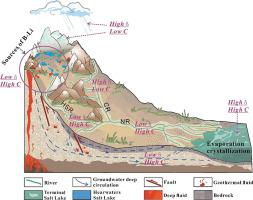Ore Geology Reviews ( IF 3.2 ) Pub Date : 2022-09-19 , DOI: 10.1016/j.oregeorev.2022.105110 Yu Zhang , Hongbing Tan , Peixin Cong , Wenbo Rao , Wanquan Ta , Shicheng Lu , Dongping Shi

|
The Nalenggele River Catchment (NRC) is the largest river sourced from the northern slope of the Eastern Kunlun Mountains (EKM). The NRC terminates in the Qaidam Basin and feeds tail salt lakes. The river–groundwater system (freshwater) and the terminal salt lakes display high concentrations of B and Li, ranking the Qaidam Basin as a world-class mineral system. However, the source, pathway, and enrichment mechanism of these elements remain unclear. In this study, the B and Li isotopes from rivers and groundwater from mountain to basin were used to trace their origin and evolution processes. B and Li are found in high concentrations even in river and groundwater with low total dissolved solids (TDS), with average concentrations tens to hundreds times higher than those of natural freshwater systems. The observed B and Li isotopic footprints are significantly depleted in heavy isotopes in the NRC if compared to other geological systems dominated by natural weathering processes. Following the confluence of one of the main tributaries of the Hongshui River (HSR) sourced from the EKM, the B and Li concentrations increase sharply, while the δ11B and δ7Li values gradually decrease. This study indicates that the mechanism accounting for the B and Li endowment of the river–groundwater–salt lake system is mainly related to the Li-B fertility of the sources (deep fluids and country rocks), favorable tectonic conduits for water circulation, and high evaporation rates. Specifically, the deep fluids upwelling is responsible for the sourcing of B and Li. These fluids are then discharged to the river and groundwater through geothermal springs developing along deep faults or within volcanic craters. In this frame, the river and groundwaters act as carriers, and input B and Li into the lake basin. Ultimately, B and Li undergo an evaporation-mediated fractionation ending with the formation of brines and eventually accounting for the formation of the world-class Li–B salt lake deposits.
中文翻译:

青藏高原东北部柴达木盆地河流-地下水-盐湖系统中硼和锂同位素成因、演化和富集过程的制约
纳楞格勒河流域 (NRC) 是发源于东昆仑山脉 (EKM) 北坡的最大河流。NRC 终止于柴达木盆地,为尾盐湖提供食物。河流-地下水系统(淡水)和末端盐湖显示出高浓度的硼和锂,使柴达木盆地成为世界级矿物系统。然而,这些元素的来源、途径和富集机制仍不清楚。本研究利用从山区到盆地的河流和地下水中的 B 和 Li 同位素来追踪它们的起源和演化过程。即使在总溶解固体 (TDS) 较低的河流和地下水中,也发现 B 和 Li 的浓度很高,其平均浓度是天然淡水系统的数十到数百倍。如果与以自然风化过程为主的其他地质系统相比,在 NRC 中观察到的 B 和 Li 同位素足迹显着耗尽了重同位素。在源自 EKM 的红水河 (HSR) 的主要支流之一汇合后,B 和 Li 浓度急剧增加,而 δ11 B 和 δ 7Li值逐渐降低。本研究表明,河流-地下水-盐湖系统的 B 和 Li 禀赋的机制主要与源(深层流体和围岩)的 Li-B 肥力、有利的水循环构造管道以及蒸发率高。具体而言,深部流体上涌是 B 和 Li 来源的原因。然后这些流体通过沿深断层或火山口内发展的地热泉排放到河流和地下水中。在这个框架中,河流和地下水作为载体,将 B 和 Li 输入湖盆。最终,B 和 Li 经历了蒸发介导的分馏,最终形成盐水,最终形成了世界级的 Li-B 盐湖沉积物。











































 京公网安备 11010802027423号
京公网安备 11010802027423号